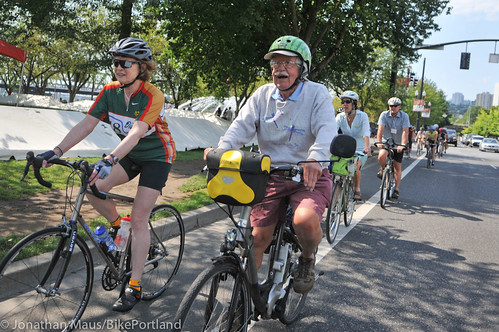
(Photos by J. Maus/BikePortland)
For ten years now there’s been one annual organized ride that might have more impact on biking in the Portland region than any other. It’s not the largest or the most high-profile ride, but it’s list of invitees definitely carries the most clout: I’m talking about the Policymakers Ride.
First held in 2005, the ride was envisioned as a way to hasten the development of a network of bikeways criss-crossing the region. But instead of another stuffy conference with panel discussions and keynote speeches, its founders — urban wildlife advocate Mike Houck and Cycle Oregon pioneer Jonathan Nicholas — figured getting bureaucrats, advocates, academics, elected officials, and other policymakers out of their offices and onto their bikes would be a much more stimulating way to educate and inspire them.
They were right.
I don’t know if you can draw a direct line from the Policymakers Ride to specific projects and progress, but I do know that big things often start with small conversations, and this ride is where many such conversations get started. It’s also one of the only times each year some of these very influential people see bicycling conditions (good, bad, and ugly) first-hand — an imperative step to building political urgency.
Advertisement

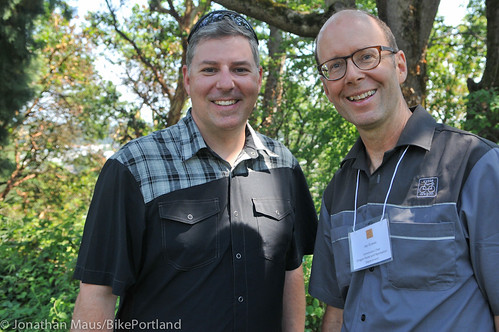


Here are a few other faces I saw in the crowd: Metro council members Shirley Craddick, Kathryn Harrington and Sam Chase; two Portland Planning Commissioners; PBOT Director Leah Treat; Portland City Commissioner Steve Novick Chief of Staff Chris Warner; former Metro Council President David Bragdon; Washington County Commissioner Dick Schouten; and numerous other advocates, city staffers, and planning professionals from around the region.
And then there was Indianapolis Mayor Greg Ballard, invited to Portland (by PBOT bicycle coordinator Roger Geller) specifically to participate in this ride. Ballard became something of a celebrity in the bike world after a keynote speech at the National Bike Summit last year.
Friday’s ride began at the Moda Center where about 150 people gathered to hear opening remarks from the ride organizers. The focus of the day was to experience the good, the bad, and the ugly of local biking conditions and to consider whether some of Portland’s iconic bikeways could become the state’s first urban route to be designated an official “state scenic bikeway.”
From the Rose Quarter Transit Center we rolled along the Willamette down to Sellwood Riverfront Park, then back north along the river to OHSU’s new Collaborative Life Sciences building in South Waterfront.
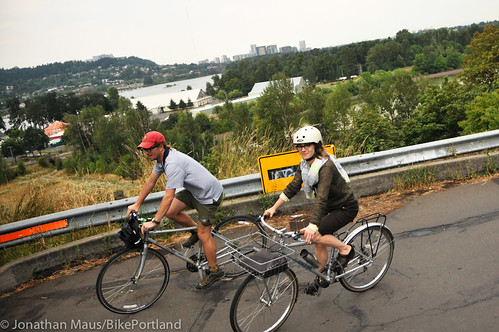



In South Waterfront, we heard from Portland State University President Wim Wiewel. Wiewel kept to a theme that found its way into several speeches: that Portland is resting on its laurels and despite all the cool stuff we’ve done, we need to keep moving forward. He urged assembled leaders to be wary of “Portland disease” that comes with the risk of “staying stymied.” For his part, Wiewel promised to tap into his “Dutch impatience to continue to get things done.”
In the shadow of the new Tillikum Crossing Bridge, we then heard from TriMet Senior Project Manager David Unsworth, who told us the first public access on the bridge will be during Bridge Pedal on August 9, 2015 (news The Oregonian reported a week ago).
From South Waterfront we rode north on Naito and Waterfront Park, across the Steel Bridge deck, then onto the NE Multnomah protected bike lane to Holladay Park.

At Holladay Park we heard from Tamara Kennedy-Hill with Travel Portland. She said Portland’s bike infrastructure is one of the agency’s “top brand stories” and that bicycling makes the region a national and international attraction.
Then Kyle Andersen with GBD architects, the firm working on the Hassalo on Eighth project, said the Multnomah Blvd road diet was an “asset to redevelopment” of the Lloyd District. He spoke of a “new paradigm” of development in the area where livability and bike access are taken seriously. Hassalo on Eighth is slated to have 1,200 bike parking spaces. The investors behind the project, he said, came from out of town and “They were surprised to learn bike parking was a requirement, but car parking wasn’t.”
From Holladay Park we headed west to University of Portland via Williams Avenue, Ainsworth, and Willamette.

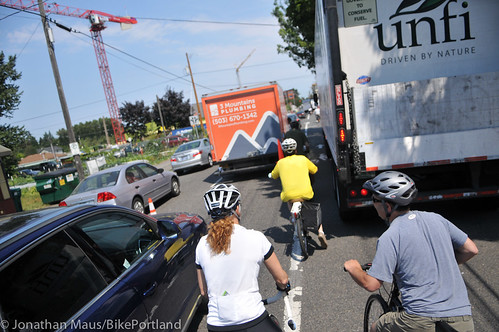

Our stop at University of Portland was on a bluff overlooking Swan Island and northwest Portland. From this vantage point we heard from college Vice President Laurie Kelley who shared her gratitude for the improvements PBOT just made to Willamette Blvd. Kelley said bike access is crucial because of their record-high 1,100 student freshman class, many of whom won’t have cars.
David Bragdon, the former Metro council president, founder of The Intertwine Alliance, and now Executive Director of Transit Center, Inc. in New York City, also took to the stage at U of P. Bragdon urged the crowd to not be afraid of taking risks, and that many great projects began as bold experiments that weren’t part of a long, drawn-out planning process. “Even the first light-rail line,” he recalled, “was a big political risk.” He said people were against the project until the day it opened.
Bragdon said the goal should be to create something that is, “not just a government program, but a movement of the people.”
From U of P we rode back to the Moda Center via Willamette Blvd, the Concord neighborhood greenway, Skidmore, and Vancouver Ave.
Back at the Moda Center at the end of ride, the group was treated to a catered lunch at Jack’s restaurant. Before going on our separate ways, we heard closing remarks from Mayor Hales and Mayor Ballard.
In his speech, Mayor Hales spoke about what he got out of the ride. “This has been a very helpful experience for us as city leaders… To hear the good ideas, to have the good conversations, to talk about the what-ifs.” Then Hales mentioned a new project that illustrates one of these “what-ifs”: “What if we just took that east lane on Naito Parkway and went ahead and made it into a bikeway? You know we really don’t need all those lanes on Naito Parkway.”
After Mayor Hales it was time for the Mayor Ballard to address the crowd.
When Ballard, a Republican and a veteran of the military took office in 2008 (it was a surprise victory in a city of Democrats), there was just one mile of bike lane in Indianapolis. Now there are 82 (including what I think is the most important piece of bicycle infrastructure in the country: the Indianapolis Cultural Trail.) By next year, Ballard hopes to have 200 miles of lanes and paths.
“It’s just common sense,” Ballard, said. “I believe the competition in cities is for talent, and bicycling is a part of that competition for the talent. I’m not doing this stuff because I like to ride bikes, I’m doing this because I’m trying to attract people into the city of Indianapolis.”
Ballard said the Cultural Trail has spurred over $100 million in development so far. “That’s a lot of property taxes,” he said. The trail has spurred not only private investment but it has also helped make the case for more biking and walking paths because planners are seeing the value they bring to the community.
While he touted his cities accomplishments, Ballard was also quick to remind us of our own. “You’re still the model; but people are catching up,” he said, “People still look to you. So get on it!”
Hopefully this powerful peloton of policymakers follows that order.




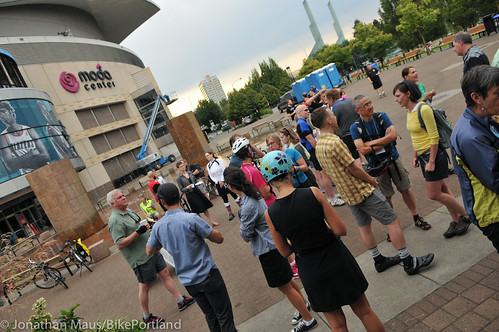



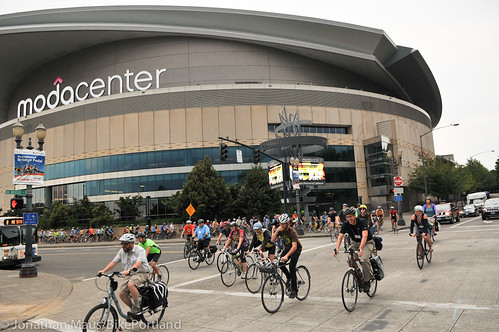
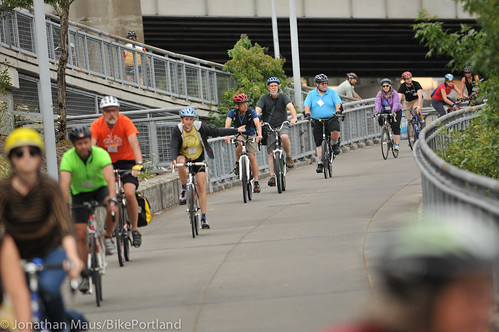





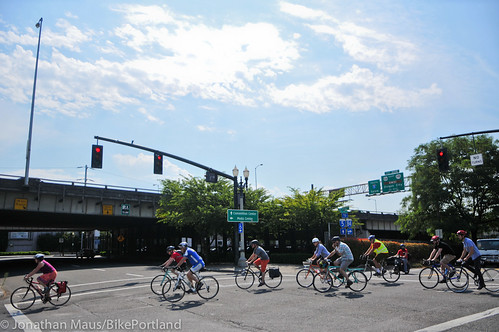

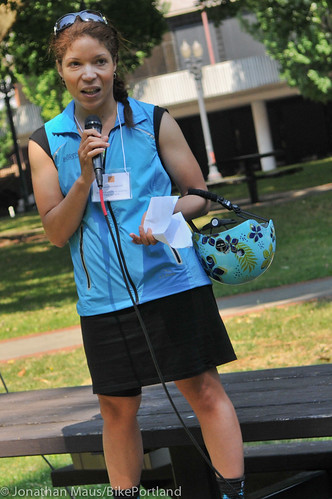




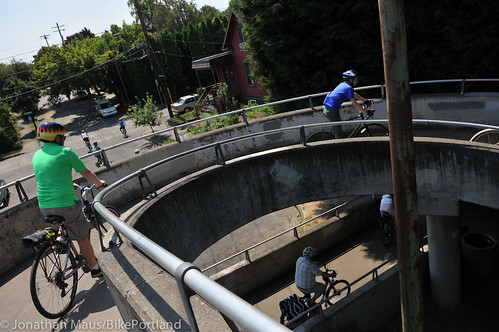








Thanks for reading.
BikePortland has served this community with independent community journalism since 2005. We rely on subscriptions from readers like you to survive. Your financial support is vital in keeping this valuable resource alive and well.
Please subscribe today to strengthen and expand our work.
Man… I would have liked to go… Damn Hernia
Love that the piece ends with a Republican standing up and pointing out the smarts behind pushing for bicycle infrastructure. It’s simply good business from a Republican’s POV, it’s environmentally sound from a Democrat’s POV… now if we can just help the blockers move out of the way of progress. 😉
Great piece, Jonathan. Very helpful to put faces to names and get a feel for the mood and conclusions. Interesting to me at least how many of the faces are of people who we’ve been disappointed in recently. I certainly hope they came along not to bikewash their misdeeds but to turn over a new leaf.
Ballard’s comment, however, struck me as odd:
“I’m not doing this stuff because I like to ride bikes, I’m doing this because I’m trying to attract people into the city of Indianapolis.”
While I am familiar with that sort of framing, neither Portland nor Indianapolis needs more people–have we fed everyone, housed everyone, employed everyone?
Why can’t we just say let’s improve things for the folks who live here?…many of whom are not fed, housed, or employed, and whose lot will hardly be improved by attracting *more people* to the region.
9watts,
The truth is that Mayor Ballard does like to ride bikes! He told me privately that he does ride for recreation and fitness pretty often and he’s working his way up to longer rides.
So, it’s important to remember that whatever you hear out of a politician’s mouth is really more about narrative and soundbites than anything else. It’s not to say it”s being dishonest, it’s more like they often have just a few specific anecdotes/talking points that they cling to in order to make a case for something or appeal to a specific type of crowd.
As for the “attracting people to Indianapolis” part… I hear what you’re saying! I think one big reason the world is in such bad shape is because we have a political/business culture that’s fixated on growth. More money, more profit, more people, more more more…. But if you think getting politicians to talk boldly about cycling is hard, most of them would consider it pure suicide to even question this pro-growth paradigm. We need someone independent or from a completely different/new political party to make that point in a way that is powerful enough to result in a lot of votes.
“We need someone independent or from a completely different/new political party to make that point …”
Probably so. Occupy was a good start.
“…in a way that is powerful enough to result in a lot of votes.”
I’m not sure I hold out much hope that our political system can handle that kind of frontal assault. I suspect once we’re ready for straight talk about economics we’ll also be due for a different political system.
The population of the USA has been growing at 0.7% a year, and the world is growing 1% a year.
Many people want to live in cities, especially nice ones with growing economies, like Portland.
Even if everyone cuts down to <2 kids per family, starting yesterday, the population will continue growing for another generation due to demographic trends and improving life expectancy.
We need to give people the choice to live in great places, rather than being forced to live in some new exurb in Vancouver WA or Phoenix AZ.
Joseph E,
Ballard was not talking about accommodating population growth. He said “I’m trying to attract people into the city”
That statement is part of growthhead, a pervasive but unhelpful mindset that privileges–often demands–growth at all costs. I appreciate Jonathan’s qualifying the Ballard quote, but still wish people (politicians included) took the trouble to speak forthrightly instead of in platitudes and focus-group tested sound bites.
“We need to give people the choice to live in great places.”
No we don’t.
If everyone did this, the (so-called) great places would no longer be great. What would have been gained?
9watts – I’m not sure what you’re advocating or how it would ever be feasible.
As long as people are free to move where they want and as long as the population keeps growing, people will move to great places. There’s no way to make sure we’ve “housed everyone, fed everyone, or employed everyone” before we “let” more people move here (short of a new constitution and a revocation of our notions of personal liberty).
Moreover, places that aren’t growing, like Detroit, have a hard time maintaining things at all, much less creating new improved infrastructure. A strategy of trying to attract people and businesses that will improve a city seems wise given these basics.
What am I missing?
“What am I missing?”
Here are three links to three different perspectives from this country over the course of my lifetime that felt this topic was important.
(1) Alternatives to Growth Oregon’s introductory narrative:
http://www.agoregon.org/page34.htm
(2) LA Times 2004 article Infinite Ingress:
http://www.latimes.com/local/la-tm-growth04jan25-story.html#page=1
(3) The Rockefeller Commission’s 1972 report Population and the American Future
http://www.population-security.org/rockefeller/001_population_growth_and_the_american_future.htm
Just because our leaders and the media and business interests (and many of us) are habituated to think that growth in everything (people, consumption, economic activity) is always and by definition a good thing–or, failing that, a necessary thing, or an inevitable thing–doesn’t mean it is, or that, when pressed, we actually agree with this. Our inclination to reject criticisms of growth out of hand is reflexive.
Let me instead ask you this:
Who benefits from growth?
Who bears the costs of growth?
What are alternatives to growth?
Why do we have such a difficult time imagining, articulating, pursuing strategies that are not tied to growth, that reject the growth fetish?
Can we really not think of any example of non-growth other than Detroit? The absence of growth is not social or cultural death; it is an opportunity to redefine and rediscover our priorities. You’ve probably all encountered Edward Abbey’s, “Growth for the sake of growth is the ideology of the cancer cell.”
You say: “As long as the population keeps growing”
*This* is the problem. The growth ideology prevents us from questioning this as the point of departure. By accepting growth as inevitable our choices are immediately and irrevocably reduced to accommodating this infinite growth. Why start from this premise? I know… everyone does, from 1000 Friends of Oregon to Lyndon Larouche. But it is no less a hopeless foundation on which to erect any kind of interesting future because people of all political persuasions ape this line. Every time we do this we are accepting growth as the natural order of things. It isn’t. It can’t be.
Everything we might want to do is made more difficult by unquestioning acceptance of population growth and insistence on economic growth.
Thanks.
I by no means meant to imply that population growth isn’t a huge problem. It is. But the problem is how to limit that growth. I’m not sure avoiding courting new or better employers is a policy that will have any meaningful impact. Looking through your websites, I didn’t see a lot of meaningful policy suggestions (other than the LA Times article suggesting we immediately close our borders tight).
Short of a Dan Brown-esque virus making 1/3 of the world population sterile, or some other less pleasant alternative, I think population growth *is*, unfortunately, inevitable. (And yes, that means, ultimately, the demise of the human race, or at least some catastrophic changes.)
“I didn’t see a lot of meaningful policy suggestions”
The Rockefeller Commission report is chock full of what I would consider meaningful suggestions. But it is quite long and I wouldn’t expect anyone to have read it overnight.
“I think population growth *is*, unfortunately, inevitable. (And yes, that means, ultimately, the demise of the human race, or at least some catastrophic changes.)”
You are certainly not alone in that view. But it suggests a failure of nerve and of imagination. Where would we be if we took that attitude about other policy matters?
I did read through their policy suggestions. They focus on developing human capital, breaking down racial barriers, encouraging urbanization. They don’t say anything about avoiding attracting new businesses to your city. (And, in fact, many could be read as *supporting* the view that we should encourage new businesses to join our cities.)
If avoiding growth is the goal, policies should focus on better education about overpopulation, free and easy-to-get birth control, eliminating tax and other policies that encourage people to have children (or even turning them around to make having children more expensive).
Trying to fight population growth by discouraging new businesses from coming to your city is like trying to win a boxing match by eating an orange.
Cites are great because they have a lot of people.
I’m not suggesting we encourage people to move to the slopes of Mt Hood, the Columbia river Gorge, or even the farmlands west of Hillsboro.
The city of Portland has 133 square miles of land, with less than 625,000 people. Central Paris has 2.2 million residents, and 1.6 million jobs, in only 40 square miles! It does this with very few buildings over 6 stories tall, in a city that is a world-renowned for beauty.
The city of Portland could easily add 1 million inhabitants and jobs within the central city, without approaching 1/3 the density of Paris, or even the density of San Francisco (pop: 840k in 47 sq miles). It could be done with relatively low-cost, wood-frame apartment buildings and low-rise offices.
Do you think Portland should be limited to those who have the good fortune to live here now? Shouldn’t people be free move here, even if it means building a few more 4 floor apartment buildings?
If not, where should they live, instead?
“Paris’s area is 10, 539 hectares for a population of 2.15 million. Parisians’ ecological footprint reached 12,838,000 gha, which exceeds their biocapacity by 313 times (41,000 gha, 0.02 gha per person). This result shows the weight of the ecological footprint on Paris’s environment, given that the city is entirely dependent on an external procurement for ressources and waste absorption.”
“France’s ecological footprint has increased by 48% in less than 40 years. In the meantime, population has only increased by 27%. Since 1961, built lands have increased by 59%, which is a clear sign of urbanization and of a more intense road networking.
The most important augmentation comes from the energy footprint, which is the area that is needed to absorb the country’s CO2 emissions. This footprint has more than doubled since 1961 (+134%, and stands alone for 58% of France’s total ecological footprint). These findings put an emphasis on France’s obvious necessity to diminish its ecological footprint.”
http://ladefense2050.wordpress.com/2011/07/06/an-increasing-pressure-over-environment/
What’s the difference between a developer and an environmentalist?
The environmentalist already has their cabin in the woods.
So you’ve got your cabin in the woods and want to deny others the same experience.
Much like a call for more density, just don’t infill my neighborhood.
You can’t have it both ways. You want Portland to have a great bike infrastructure but don’t want it to draw in more people who would use that infrastructure.
We may as well stop any development because we’ve got enough people here already.
“want to deny others the same experience.”
A cheap shot. The point is that with an attitude of either (a) everyone should have access to what I have, or (b) because we can’t think of a reasonable way to tackle this problem let’s just pretend it isn’t a problem, all we get is a race to the bottom, a deterioration of the very qualities that make some places nice(r) places to live. Not tackling this problem just kicks the can down the road.
Although for some I’m sure talk of limits to growth is about denying privileges to others, using that argument to shut down conversation about this subject is not constructive; it just shows that you would prefer we not talk about it.
“You can’t have it both ways. You want Portland to have a great bike infrastructure but don’t want it to draw in more people who would use that infrastructure.”
This makes no sense, meh.
Having something (bike infrastructure, a legal system, a great blog to read every day) and wooing others to come and move in upstairs are two completely different, unrelated, things. I’m not understanding how you see them as linked, as necessarily coupled. Can you explain?
The bike infrastructure in Portland that I (may) want is necessitated by the overwhelming presence of the automobile. Those who habitually drive should in my view pay to build the infrastructure to accommodate those whom their preferred activity displaces or endangers. As such, this is a matter that arises between groups of people already present. It has nothing at all to do with not-yet-present future residents who may or may not wish to bike or drive.
The idea, implicit in some posts here and explicit in others, that we should try to stack the deck, get those who share our modal proclivities to move here in greater numbers than those who get around by other means, is endearing but has nothing to do with whether I can bike around town today.
Your response previously was
” “We need to give people the choice to live in great places.”
No we don’t.
If everyone did this, the (so-called) great places would no longer be great. What would have been gained? ”
So you are being selfish. Don’t let people come to great places, at least not your great place because it won’t be great anymore.
And how do you suggest we stop people coming to this great place? Which rights do you want to restrict?
Do you want to be restricted to living exactly where you are for the rest of your life?
The original statement was about “CHOICE”.
Why does this degenerate so easily into Soviet chimeras? Choice is meaningless without a framework which regulates what happens when my choice comes up against, threatens, or cancels yours. You are in essence arguing for no framework because you’d rather not think about the messy realities of and limits on choice. I’m saying the world is a complicated and fraught and increasingly full place, and to live well, to make good policy decisions we sometimes have to face difficult public choices (ha!), not just the ones that arise in the private realm.
I recommend Zygmunt Bauman’s Globalization: The Human Consequences. New York: Columbia University Press. 1998 for a helpful discussion of choice.
“Questioning the ostensibly unquestionable premises of our way of life is arguably the most urgent of services we owe our fellow humans and ourselves. ”
“And how do you suggest we stop people coming to this great place? Which rights do you want to restrict? ”
Your antipathy to thinking seriously about this subject is clouding your ability to acknowledge that limits & a consequent need to consider restrictions are a fact of life, and become more urgent as our numbers grow. Congestion pricing is, in principle, no different than what you’re suggesting is inadmissable talk about human population growth and mobility. If we hope to solve our society’s problems, many of which are the result of–or exacerbated by–growth of all sorts, we need to eventually face this particular music. The fact that you find this subject unpalatable does not make it go away.
To give just one example, China, everyone’s favorite whipping boy when it comes to draconian social policies, has just lowered their annual car-licensing quota (bringing this back to transportation). This has long seemed to me a simple and effective if no doubt unpopular-with-some way to tackle that particular problem. If we lived in what Herman Daly referred to as an empty world we wouldn’t need these policies, these restrictions. But in a full world where most everyone refuses to speak and think honestly about these matters they become increasingly necessary. You can’t have it both ways: refuse to talk about population and no restrictions 🙂
http://thecityfix.com/blog/congestion-pricing-make-beijing-more-equitable-city-ying-wang/?utm_source=feedburner&utm_medium=feed&utm_campaign=Feed%3A+thecityfix%2Fposts+%28TheCityFix%29
It’s not about growth it’s about how you slice the pie. I have no problem at all with attracting all the smart, conscious, engaged people we can, so that Portland can continue to pave the way. And I agree that biking is THE way to do that. If Greg Ballard ran for Portland mayor, I’d take a long look at his other positions, that’s for sure.
“so that Portland can continue to pave the way”
You’re starting to sound like that smiley guy in a blue sunday parkways T shirt. 🙂
“It’s not about growth it’s about how you slice the pie.”
I’m curious what you mean? Can you elaborate?
I’d rather the people who leave be drivers, and the people we attract be bicyclists, on balance. I’m about Portland making itself more different from the rest of the country. People who don’t like that have plenty of other options.
the democrats in name only party sold the last dollop of their shame during the clinton presidency.
We should make them take a liberal purity test……
I love the pictures of the truck blocking the bike lane on Williams. So typical… Williams and Vancouver are two of the busiest bike lanes in all of PDX because they connect North and NE to downtown and unfortunately they are not safe for kids. Really looking forward to the improvements coming this fall. Nice job PDOT!
Unfi: “Driven by Nature”
So bummed I missed this ride. My excuse? Husband was hit by a car while on his bike, and required surgery that happened that morning. 🙁
(He’s okay and recovering, and my desire to make our streets safer is stronger than ever.)
Cat 1 coverage, JM!
I agree about Naito needing to be updated for cyclists. During the summertime, the Waterfront Park bike path is a MESS. A good mess (ie it gets used), but a MESS nonetheless. There are thousands of tourists staggering EVERYWHERE unpredictably, making it really dangerous to bike through. But I find the bikelane on Naito uncomfortable, and still prefer to take the Waterfront Path.
And let’s talk about closing the “Naito Gap” too, shall we? What’s the point of a bikelane on one side of the Steel Bridge, a bikelane on the other side of the Steel Bridge, and NOTHING inbetween. I still can’t teleport!
True, I am comfortable enough in the Naito bike lane but in the summer time there with all the activities in Waterfront Park and the lack of a sidewalk along the east side of Naito, the bike land can be full of pedestrians.
While I certainly wouldn’t consider the Naito bike lanes great, I don’t mind cycling in them myself. At least there’s Waterfront park as alternative. If it was one or the other, I would prefer that they concentrate on fixing the Naito gap at the Steel Bridge, and extending the Naito bike lanes further south, at least to SW Harrison.
Until neither is an option when they do big events in the park. The path becomes way too crowded and they have sometimes put fencing in the bike lane. Even if they don’t, the lack of sidewalks often means people walking in the bike lane.
It goes from a pretty good set up to a really lousy one pretty quickly come summertime.
I sometimes wonder why there isn’t a sidewalk on the east side of Naito. There seems to be enough room between the trees and the curb, and it would prevent people walking in the bike and/or general traffic lanes.
I’m so glad you all went up Williams and down Vancouver. It’s been incredibly stressful there this summer, with several major projects having taken over the sidewalks and part of the streets around both north and south of Fremont. It’s quite frustrating and at odds with the “bike highway” that people like to tout.
Yes Williams was the “ugly” part of this year’s ride…not so ugly compared to past “ugly” facilities visited in past years (ugly = lack of any facilities)…but ugly given the volume of bike traffic on existing bikeways AND motorized road operator behaviour…plus the cluster f— of the development projects without good traffic management and TDM (creating alternative construction detour routes for bikes and others).
I sure hope next week’s project open house really solves this corridor’s bike traffic growth and the traffic pains…
My fear is that the plan is already outdated given the incredible volume of development that’s happened since it was completed.
I somehow missed the pic of Steve “never met a tax I didn’t like” Novick riding.
Probably because he can’t ride a bike. As mentioned once on bikeportland, it’s on his list “along with learning Italian.” (http://bikeportland.org/2014/05/30/matter-politicians-ride-106492)
My one disappointment with the messaging is that there is almost nothing about Greenways OR parents and kids biking / safe routes to school.
My 3 year old can navigate the Going St / 33rd cycle-track, but if the policymakers don’t, then how can they prioritize my emails to safe@portlandoregon.gov ? Family biking is such a vital part of Portland, but it doesn’t get much air time.
If policy makers care about building bike infrastructure instead of “fixing outdated” already existing stuff like they like to waste money on, send them up my way – let’s put their money where their mouths are and have them ride down 92nd/Glisan or the Halsey overpass. This is kind of a joke.
Yeah, middle class white people are inconvenienced with less than stellar bike commuting. How about making transportation accessible to low-income minorities?
Yes, not going further east than about 12th is kind of ridiculous and insulting (esp. considering that it seems most in city government don’t leave east of about 30th.
The ride has a different route each year. It took all of 20 seconds on Google to find out that the 2012 route included the I-205 bike path and the Holgate buffered bike lanes. http://bikeportland.org/2012/07/18/bigwigs-set-to-roll-on-8th-annual-policymakers-ride-74911
Again. Edgefield? Champoeg? I would love to go enjoy these places on my ample time off. Pfft. How about they start in the Fubonn’s or WalMart’s parking lot? Let’s be a little more realistic about commuting and not live in a dream world where people only bike for recreation and tourism.
Damned if you do, damned if you don’t.
I don’t really follow. So it’s unreasonable to expect that a ride that is supposed to represent normal Portlander’s biking routes, wouldn’t include normal biking routes? (and i’ll give you that at least this year included Williams/etc.)
The original point was a complaint that the ride focused on the central city and not East Portland, I guess with the implication that it’s unreasonable to ever spend effort or money on improving cycling conditions in the central city. I pointed out that only two years ago the ride was entirely east of 82nd. But somehow that doesn’t count, because the route they chose was too good or something. (Marine Drive, I-205 bike path, Holgate bike lines, Springwater Corridor, Gresham-Fairview trail). As if all of that infrastructure was built for free.
Seriously? You’re touting a leisure ride on two of the best separated bike paths we have (and Marine Drive) as getting into the meat of Portland?
If this is the route we’re showing to our politicians I’m not surprised that infrastructure east of 39th hasn’t seen much improvement the last few years (I’ll give you a few wins with Holgate etc.).
Nothing east of 39th? Seriously? How about the bike lanes on SE Division between 60th and 80th? Or the 50’s bikeway? Or the Foster Streetscape Plan? Or the sidewalks on SE 122nd between Holgate and Ramona? Or the new sidewalks on SE 136th? Or the sidewalk infill on SE Division east of 82nd? Or the 130s bikeway (not yet under construction, admittedly.) Or the planned Gateway Green bike park? Or, in non bike/ped projects, the MAX Green Line? Or the Division/Powell transit corridor being planned by Metro right now?
Half the things you’re citing aren’t yet built.Sure there have been some wins, but I don’t think it’s a stretch to say that infrastructure in outer Portland has not kept up with what’s being built inner.
I’m not trying to argue with you, but are you saying that these rides have been a good representation of normal riding conditions in this city? And are you associated with the ride?
I just don’t know that this ride (or even a ride that includes two separated bike paths and a new buffered bike lane) will educate politicians much on what it’s like to ride out in the eastern parts of the city. I think this is especially a big deal as none of our city council members live east of 39th, where a majority of the city lives.
I’m not associated with this ride, or indeed any cycling organizations / local government agencies. I did once meet Charlie Hales at a party, and he was very nice.
Portland east of 82nd developed very much around the needs of the automobile, a sad consequence of that era in urbanism. It wasn’t part of Portland when most of the roads were laid out, and it’s a shame that Multnomah County let the developers build giant arterial roads without sidewalks, and create numerous local streets (often without paving) that don’t connect to each other in any logical way. Fixing this isn’t going to be easy. Of the projects I listed above, every single one is I whole heartedly support. I think we should be doing more of them. We should be building sidewalks until there isn’t an arterial street in Portland without sidewalks. And then we should move onto doing the same on the neighborhood collectors.
What annoys is me that almost whenever there’s an article on BikePortland about something happening in the Central City, people start saying “what about East Portland”. Well, I’m sorry, but ignoring the needs of the densest part of the entire state isn’t a great strategy for moving the city away from being car dependent.
It tends to be commentariat’s favorite pastime here. There have been several instances of individuals showing open contempt towards the Central City, and the idea of becoming a more dense, urban place. That’s why the streetcar tends to be an easy target (it’s emblematic of everything they think is wrong with the city’s spending priorities).
“Well, I’m sorry, but ignoring the needs of the densest part of the entire state isn’t a great strategy for moving the city away from being car dependent.”
Nor is ignoring a section of the city that has the most population.
I’m not anti central city infrastructure, I just think that most politicians and employees at PBOT (and some of the commenters on this website) just have a skewed perspective of what it means to live and move around in this city. I would hope that a ride like this could help give them a first hand experience of what that looks like (and get them out of the neighborhoods where most of them already live).
This is great. Good coverage and thanks to the policy makers (and others) for taking the time. I am really interested in hearing more about the comment from Mayor Hales about Natio Parkway. Many people in the SW end up on Natio Parkway after the roll off Barber. There are lots of opportunities to make Barber and Natio Parkway better, if it were made as safe as the Williams lane you covered today we would see a lot more ridership.
“The city of Portland could easily add 1 million inhabitants and jobs within the central city”
I prefer density to sprawl as much as the next person–no, probably more–but what you just wrote is insane. Jobs and building lumber isn’t the half of it, Joseph E. What about food? water? sanitation? transportation? … This leads nowhere any of us want to be. We haven’t figured out how to solve any of the major social, economic, environmental problems we already have; you’re not really suggesting that adding a million people will improve our chances are you?
“where should they live, instead?”
Let me propose that instead of repeating this hopeless mantra endlessly we consider the conclusion of the Rockefeller Commission’s 1972 report Population and the American Future:
“After two years of concentrated effort, we have concluded that, in the long run, no substantial benefits will result from further growth of the Nation’s population, rather that the gradual stabilization of our population through voluntary means would contribute significantly to the Nation’s ability to solve its problems. We have looked for, and have not found, any convincing economic argument for continued population growth. The health of our country does not depend on it, nor does the vitality of business nor the welfare of the average person.”
(link to report in comment replying to Ciaran)
So you either support:
1. Build the dang fence! (keep immigrants out)
or
2. Murder people to keep the population down.
Which one is your solution?
I support neither and don’t know why you find it constructive to take what we all know is a touchy but important subject and drag it into the gutter of tabloid headlines.
I guess I just don’t understand your point in the context of this discussion. We already have excellent birth control coverage in Portland, so we are doing our part. We can’t help that people want to move here, so we need to accommodate them somehow. What other option do we have? Population control is not included in the scope of our regional planning government, nor should it be.
Chris I,
thanks for returning to this discussion in a more civil manner.
I had no intention of having a full-blown fight about population & policy here on bikeportland. My point was simply that Ballard’s focus on attracting people to move to his city was misguided. Because he is not alone in that attitude about population growth as beneficial (or necessary or inevitable) I felt it worth calling out. I am surprised, though, how many bikeportland commenters, who are otherwise thoughtful, interesting, even occasionally brilliant, treat this subject as open and shut; nothing to be done.
You wrote:
“We can’t help that people want to move here, so we need to accommodate them somehow. What other option do we have?”
This is a common view, and understandable if only because we so rarely seem to get past soundbites and potshots on this subject. The interstate commerce clause notwithstanding, I don’t think we ‘have to accommodate them somehow.’ First of all we are, right now, not merely accommodating them, our leaders are wooing them, incentivizing people and businesses to move here. This should be an easy thing to quit. As for accommodating, it was our erstwhile governor McCall who realized that we could and perhaps should take a different approach. “I urge them to come and come many, many times to enjoy the beauty of Oregon. But I also ask them, for heaven’s sake, don’t move here to live.” http://www.opb.org/artsandlife/article/former-governor-tom-mccall-message-visitors/
Smart, thoughtful people have articulated this view and had their (not necessarily only xenophobic or privileged or classist) reasons. It can be simply pragmatic. Refusing ever to talk about population growth leads to all sorts of mischief because each of us is left to speculate about the others’ (mostly unheard) views; read into them all sorts of motives or misgivings that may or may not be there.
“Population control is not included in the scope of our regional planning government, nor should it be.”
You’re certainly right about the first part, but I don’t agree that this is the natural order of things. I’ll ask you: why should it not be? What do we gain by avoiding this subject? You may want to look at the link I posted earlier from Alternatives to Growth Oregon. Latter day Tom McCalls, trying to figure out how we could stop doing things that our leaders reflexively do, but that don’t benefit Oregon or Oregonians.
http://www.plannedparenthood.org/health-info/birth-control
So, in reference to the other post today re. attendance at public meetings, why bother when these people make all the decisions? Probably better to start an actual (old-school) letter writing campaign than to waste time at endless advisory committee and neighborhood assn meetings…or go on one of these rides (if you know about it) and harange those in a position to make policy and project decisions…
Corking or not corking?
mostly not corking although I’m sure some did take place. the group split up quite a bit. One annoyance of mine was that there were a few folks trying to direct traffic around us at tricky intersections (at least one of them was a retired Oregon State Trooper who does course marshalling for Cycle Oregon). I think this disrupts the natural flow of traffic and it takes away from the realistic conditions this ride is supposed to highlight. I plan to share the feedback with Cycle Oregon and suggest they don’t have people doing this next year.
That’s good feedback but how “realistic” are the conditions even without corking? It’s a guided tour during off-peak hours in gorgeous weather, large groups of riders to increase safety, many of them are accomplished at city riding to help any less-skilled ones navigate along the way. Contrast that to a solo rider, less experienced, facing unfamiliar routes during dark, commute time or foul weather. The ride is a great idea but I hope someone points out to the participants that they’re in an insulated bubble compared to many other people biking the streets.
you’re preaching to the choir Alan. I totally agree with you… But I’d say this is much better than nothing and the goal is to give folks a taste of what’s out there.. not to scare them away so they don’t come back next year.
Could we scare them into doing something about it though?
In a conversation with Tobias Read, “bikes should pay a registration fee” and “studded tires should pay nothing” he was also a huge proponent of the failed CRC. I hope he learned something on the ride.
Bud Clark is still riding a bike, be it an e-bike, beats driving anyday.
Great post! Outstanding photos and text – thanks.
Yeah well, he’s already learned to talk like a pirate
“‘Garrrrr, ‘tween giving half our pieces of eight back in tax rebates to the rich and jumping at every new drivelswiggered GOP project that comes along, ’tis no wonder there be no booty in our hold,'” Novick was heard sayin’ as he loaded supplies for International Talk Like a Pirate Day. “Methinks it be fine time old ‘Red Ink’ was retired from command of the good ship Junior Senator from Oregon.”
http://www.dailytidings.com/apps/pbcs.dll/article?AID=/20070920/OPINION/309209969
That Ashland motorcycle cop would have been in a frenzy , if he’d been there ….. all those riders out of the bike lane .. 🙂
The first picture’s caption stated the bike lane was narrow and outdated. It sure doesn’t look that way to me. The few bike lanes we have in Houston, Tx are much worse than that. They were laid out with paint with an eye to minimizing width, no other improvements at all. There is a lot of bike riding here but we all have to have confidence to take the lane.
Who are the organizers of this ride? I didn’t happen to see any mention of who puts it together in the article.
Good question. It’s managed by Cycle Oregon, the same folks that do the big statewide recreational tour.
I love that pic of Naito. I still cant believe that it was repaved without a two way cycletrack. That facility is ridiculously unsafe, so like most others, I dodge people on the waterfront path so I can avoid the frequent stop lights and cell phone using people speeding down naito
funny how motorvehicles going opposite directions are never forced to share a dangerous narrow lane.
except on most of Portland’s narrow residential streets…
I wouldn’t say “never”…Some of the residential streets I take on my way home are 2/3 blocked by parked cars, leaving only about one car-width for travel. Oncoming drivers usually expect me to yield to them on such streets, even when I’m huffing it uphill. I guess yielding to uphill traffic only counts among motor vehicles.
Have you tried just not yielding to people driving oncoming cars? In cases where I think I should have priority (some mix of “I was there first” if the car just turned on the street, comparative convenience of turn-offs, etc – pretty much the same calculation as I would make while driving) I conspicuously take the entire lane. Somtimes I go a little into the other half of the lane so the driver can’t reasonably think I’m just gonna squeeze to the side in the door zone or something. Cars usually yield when I do this. However it can be a little uncomfortable because I think many drivers have no notion of the door zone and expect bikers to squeeze into the remaining space.
it looks like this ride is helmets-required…
if they really want to get a sense of how comfortable the streets are for the entire population it should be required that nobody wear a helmet…
if all of those riders feel safe riding without a helmet then we’re doing something right…